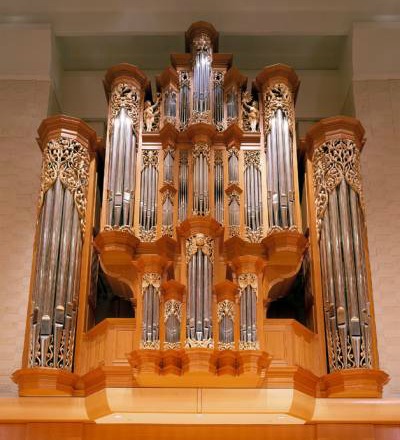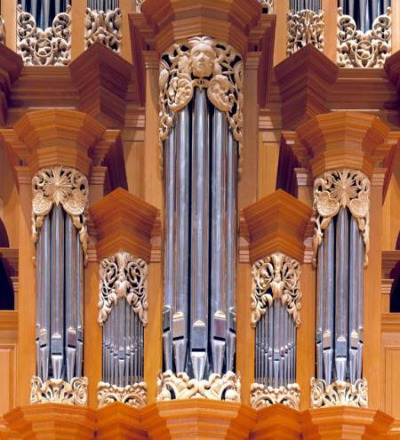The Gottfried and Mary Fuchs Organ
Thanks to the vision of Professor Emeritus David Dahl and the financial help of many, in particular the Fuchs foundation, a magnificent organ of 54 stops with three manuals and pedal was installed in Lagerquist Concert Hall at the Mary Baker Russell Music Center. Built by Paul Fritts and Co. of Tacoma, WA, it was finished in 1998 as Opus 18.
The Gottfried and Mary Fuchs Organ is a mechanical-action (“tracker”) organ, meaning that the action allowing air to pass to the pipes is purely mechanical, with no electrical components other than the blower. The basic concept of the “tracker” organ has changed very little since its development in the Middle Ages. Pressing a key activates a series of levers, springs, and push rods that let the air pass from the bellows to the pipes—the keys literally are suspended from the valves below the pipes, providing the organist with intimate, reliable contact to the winding of the pipes. Sometimes the distance between the keys and pipes is more than 30 feet. Most of that distance is spanned by the aforementioned trackers, which are very thin strips of sugar pine.
The case is made from old growth Douglas Fir, carefully salvaged from downed trees otherwise left in the forest. The logs were then sawed down just a few blocks from the Fritts shop. This noble wood has, over the years, darkened to the deep honey color we see today. The carvings, designed and carved by the builder’s sister Jude Fritts, are made of Basswood sourced from the Appalachian Mountains. There are 224 square feet of carvings on the organ. In addition to the carvings, this wood was used for the keys and some parts of the action, given its stability and strength relative to its weight. For more information on the organ’s carvings, please visit Jude Fritts’ website.
The Fritts workshop is located just over a mile from PLU. All of the parts of the organ (except for small hardware items, the blower, and the preset system) were made onsite from raw materials. This includes the pipes that began as ingots of tin and lead and were then melted and cast into sheets on a casting table. These sheets were hammered or planed and then cut, rounded, and soldered together to make the instrument’s 3,912 pipes.
The essential sounds found within the pipe organ:
The Principals
The essential and most characteristic singing sound of the organ is derived from the open cylindrical pipes that one can see on the front of the organ case. When several sets of these pipes are used together at high and low pitch levels, the organ sounds its “plenum” or principal chorus. The mixture stops—some with seven pipes sounding per key—add sparkle and brilliance to the top of the principal choruses of each “division” or section of the organ.
The Flutes
Sweet, warm, and round in sound, the flute pipes provide a wide array of timbre in gentler tones than the principals. Also arranged in choruses for each keyboard, flute pipes are constructed in many different ways: fully open, completely capped, partly capped with chimneys, and even tapered like a steeple.
The Strings
This family of organ are made more narrowly than the principal pipes, generating a lighter-weight tone with a silvery quality. A special combination of string pipes pairs the Viole de Gambe with the Voix Celeste, the latter of which is tuned slightly sharp to create an ethereal, undulating sound.
The Reeds
While the first three types of pipe tone are generated from “flue” pipes (analogous to a whistle or a recorder), the reed pipes create tone by means of a vibrating brass tongue that works similarly to the reed of a clarinet or saxophone. Differently-shaped resonators permit a variety of timbres that resemble woodwind and brass instruments, such as the trumpet, dulcian (a predecessor of the bassoon), oboe, and trombone. Reed pipes are used either for solo purposes or to add power to a full ensemble. The Gottfried and Mary Fuchs Organ is remarkable for its large number of reed stops (14), each requiring great skill and time to voice and regulate.




